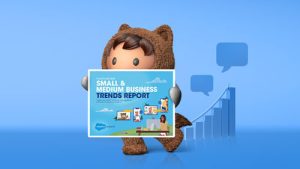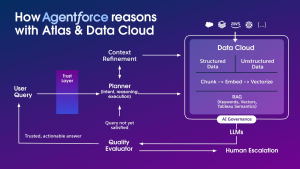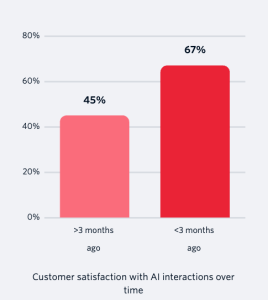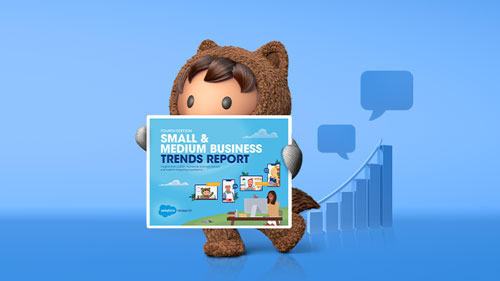Key Takeaways
For small and medium-sized businesses (SMBs), standing out in a crowded market can be difficult, especially when competing against large enterprises with a bigger budget. That’s why we found growth strategies to be important for anyone looking to scale business in 2026 and beyond.
Today’s business buyers want more than just a good product or service: In fact, 80% say that the experience a company provides is as important as its products and services. Here are six ways small businesses can grow their impact:
What we’ll cover:
- What is a growth strategy?
- 1. Reach the right customers with smart automation
- 2. Create a sales playbook
- 3. Use AI analytics to make smart decisions
- 4. Triple your growth with hyper-focused partners
- 5. Improve post-sale support with AI
- 6. Get work done globally with Slack
- Your small business can become big
What is a growth strategy?
For a small business, a growth strategy is your tailored plan for expanding beyond your current size without running out of resources. It focuses on how to sustainably increase profit and customer base using limited means.
This usually means starting with market penetration, such as creating a loyalty program to get existing customers to buy more often. As you stabilize, you can strategically introduce new services (product development) or target a nearby town. The key is to choose one or two focused growth avenues that align with your cash flow and allow you to test expansion slowly before making big, risky investments. Here are a few to consider for the future of your business.
1. Reach the right customers with smart automation
Imagine having a tool that helps you reach the right person at just the right time. With automation built into a customer relationship management tool (CRM) like Salesforce, you can create email campaigns that really connect with your audience.
For instance, the moment a prospect fills out a contact form or engages with a chatbot, their data is saved in your marketing CRM and a thank you message is automatically sent out. There are also email drip campaign sent after a certain action was taken by a user, like signing up for a newsletter or downloading content.
This type of automation helps prioritize prospects by scoring them based on their behavior and interests. With access to marketing analytics built in your CRM, you get a clear picture of what’s working across your campaigns.
Automated emails can be triggered based on specific actions, like reminding someone about a product they checked out but didn’t buy. It even segments contacts based on their actions, ensuring the right message is sent to the right group. And it doesn’t stop there, it can also gather post-purchase survey feedback and use it to make the customer experience even better.
AI Tools for Small Business
2. Create a sales playbook
The best sports teams’ successes come from creating a plan. And just like a coach, you need to be clear about your team’s goals and expectations and lay out a sales plan to get them there. This is especially important in business-to-business (B2B) sales, where 84% of business buyers expect sales reps to act as their trusted advisors.
Develop clear sales playbooks to create a consistent process for all prospects. Here’s how to create a sales playbook, step by step:
- Define your vision: Lay out your mission, values, and how your product solves customer pain points. Include common objections and effective responses.
- Build a clear sales process: Define your target audience, key personas, and lead nurturing steps. Highlight how data analytics and tools help streamline your sales strategy.
- Keep it flexible: Think of your playbook as a living document. Regularly update it with team feedback and new insights to stay ahead.
For instance, by using AI to structure sales territories, you can avoid multiple sales teams reaching out to the same prospect with different products or opportunities. You can also set sales quotas to give your team clear goals, helping everyone stay aligned and accountable for better results.
What can you do with a CRM built to reach more prospects?
Automate your marketing campaigns with a CRM built to grow. It all starts with Starter Suite.

3. Use AI analytics to make smart decisions
Artificial intelligence (AI) is now fueling small businesses, helping to advance sales, marketing, commerce, and operations. When AI and CRM work together, your teams gets the support they need to handle their workload, making it easier to keep customers happy.
For example, if you need to create a proposal, you can access the latest product information directly from your CRM and generate the proposal automatically. This saves time and eliminates the need for constant back-and-forth.
Now, imagine providing your team with a tool that helps them work smarter, solve problems faster, and build better relationships with customers. That’s what Agentforce 360 does. It reviews customer data to suggest what they might need next, like recommending accessories after buying a phone. Using AI agents for service helps your team anticipate problems before they happen, turning them into proactive problem-solvers.
4. Triple your growth with hyper-focused partners
Two heads are almost always better than one, so consider amplifying your small business growth strategies with partners. The right partnerships deliver the benefits of a bigger sales team without the downsides of increasing headcount. The key is ensuring that all prospects have the same amazing experience, whether they’re talking to an in-house team or your partner.
To keep your partners and sales teams on the same page, a CRM is key but a communication integration like Slack is mandatory. With Channels, it ensures everyone has access to the same information, whether it’s sales playbooks or customer-facing materials. For example, if your sales team is talking to a customer and your partner is also reaching out, they’ll both have the same details about pricing, features, or promotions, avoiding any confusion.
5. Improve post-sale support with AI
An AI CRM can do a lot to support your team, but one of its biggest perks is how it powers personalized, 24/7 customer service, even when your team’s off the clock. Agentforce 360 provides a comprehensive, holistic view of each customer, consolidating all interaction history, purchase details, and service records in one place. This ensures that support agents have all the necessary information at their fingertips to address customer issues efficiently.
For small businesses, you may not have your team built just yet, so utilizing AI for customer support is a solid strategy. Here are two ideas to think about:
Create a self-service community: An AI-driven self-service community gives them quick access to helpful guides, product info, and FAQ pages. AI can predict common issues and automatically posts answers; hence quick answers are guaranteed. Plus, if things escalate, your service team gets a heads-up to jump in and help out.
Free up your team with service agents: AI-powered chatbots are the helpful virtual assistant that never sleeps. They can handle simple questions and provide personalized help around the clock via text or chat. These AI agents have come a long way, making them a great option as your business grows. They can take care of big product catalogs and more complex service needs, so your team doesn’t get overloaded.
Grow Your Small Business With AI Agents
Learn how autonomous AI can scale your small business for efficient growth in our free e-book.

6. Get work done globally with Slack
The free version of Slack can become the backbone of customer management for any small business that relies on teamwork. While it’s not a full customer tracking system on its own, it excels at centralizing communication.
You can set up dedicated channels right inside your CRM, which brings all relevant conversations and files into one easy-to-search place. This eliminates the chaos of scattered emails and ensures that every team member, from the person who answers the phone to the person who handles billing, sees the same, most recent information.
Turn messages into action items: By using the Save Message feature or the three-dot menu on any message, you can easily turn a customer request or a key instruction into a to-do item that your team can follow up on, ensuring nothing falls through the cracks.
Create “mini-CRMs” with Threads: When a customer sends a message with an issue, your team can use a thread to discuss the solution privately under that original message. This keeps the main channel clean, and anyone joining the team can see the history and the solution in one compact spot.
Boost team productivity with Slack
Bring together your team, your customers, and your tools to help take your business to the next level with Slack — it’s where business gets done.

Your small business can become big
As a small business, you have the power to scale your impact significantly by leveraging the right tools and strategies. With these unique strategies, you’re not just growing your business — you’re scaling your impact. At Salesforce, we’re here to support you every step of the way.
Ready to take your business to the next level? Try Starter Suite to stay organized and build lasting customer connections. Looking for more customization? Explore Pro Suite. Already a Salesforce customer? Activate Foundations today to try Agentforce 360.
AI supported the writers who created this article.























